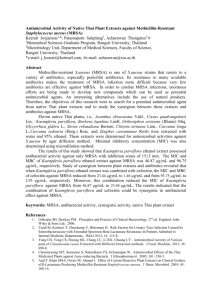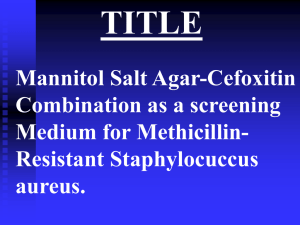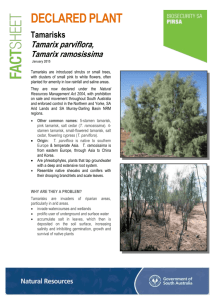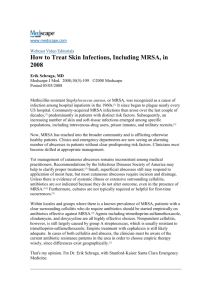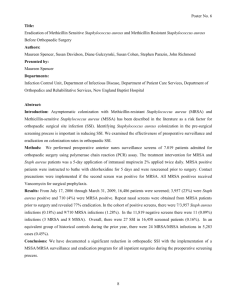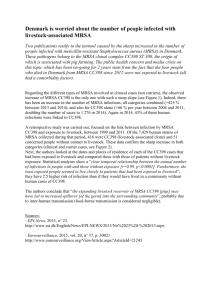Angsana New 16 pt, bold
advertisement
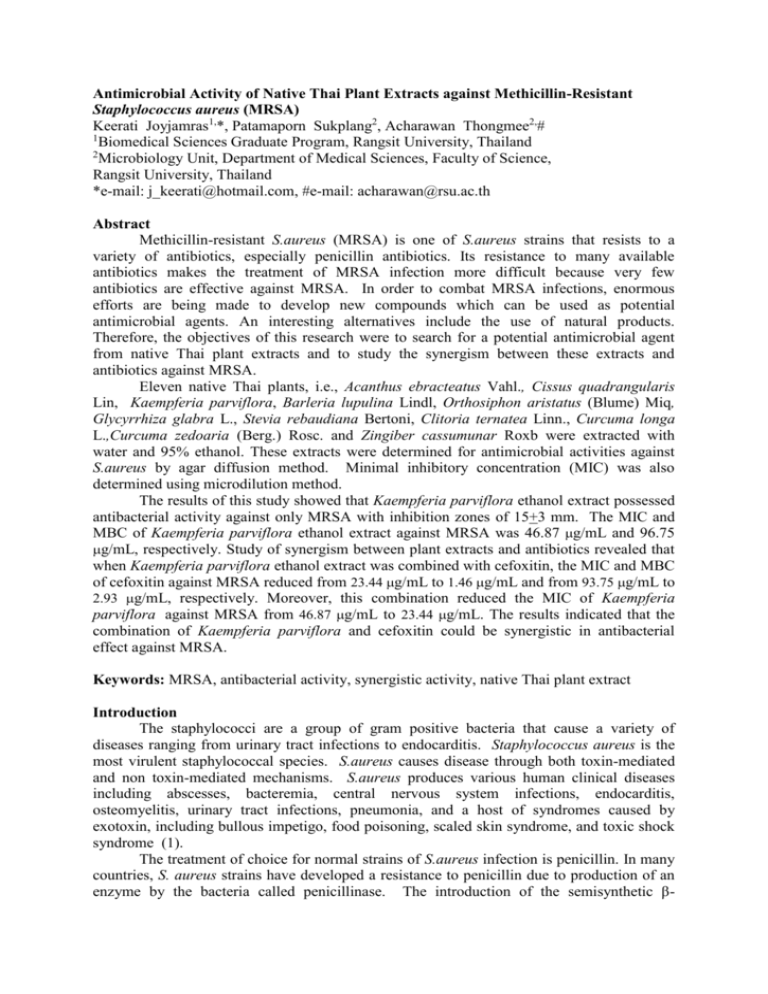
Antimicrobial Activity of Native Thai Plant Extracts against Methicillin-Resistant Staphylococcus aureus (MRSA) Keerati Joyjamras1,*, Patamaporn Sukplang2, Acharawan Thongmee2,# 1 Biomedical Sciences Graduate Program, Rangsit University, Thailand 2 Microbiology Unit, Department of Medical Sciences, Faculty of Science, Rangsit University, Thailand *e-mail: j_keerati@hotmail.com, #e-mail: acharawan@rsu.ac.th Abstract Methicillin-resistant S.aureus (MRSA) is one of S.aureus strains that resists to a variety of antibiotics, especially penicillin antibiotics. Its resistance to many available antibiotics makes the treatment of MRSA infection more difficult because very few antibiotics are effective against MRSA. In order to combat MRSA infections, enormous efforts are being made to develop new compounds which can be used as potential antimicrobial agents. An interesting alternatives include the use of natural products. Therefore, the objectives of this research were to search for a potential antimicrobial agent from native Thai plant extracts and to study the synergism between these extracts and antibiotics against MRSA. Eleven native Thai plants, i.e., Acanthus ebracteatus Vahl., Cissus quadrangularis Lin, Kaempferia parviflora, Barleria lupulina Lindl, Orthosiphon aristatus (Blume) Miq, Glycyrrhiza glabra L., Stevia rebaudiana Bertoni, Clitoria ternatea Linn., Curcuma longa L.,Curcuma zedoaria (Berg.) Rosc. and Zingiber cassumunar Roxb were extracted with water and 95% ethanol. These extracts were determined for antimicrobial activities against S.aureus by agar diffusion method. Minimal inhibitory concentration (MIC) was also determined using microdilution method. The results of this study showed that Kaempferia parviflora ethanol extract possessed antibacterial activity against only MRSA with inhibition zones of 15+3 mm. The MIC and MBC of Kaempferia parviflora ethanol extract against MRSA was 46.87 g/mL and 96.75 g/mL, respectively. Study of synergism between plant extracts and antibiotics revealed that when Kaempferia parviflora ethanol extract was combined with cefoxitin, the MIC and MBC of cefoxitin against MRSA reduced from 23.44 g/mL to 1.46 g/mL and from 93.75 g/mL to 2.93 g/mL, respectively. Moreover, this combination reduced the MIC of Kaempferia parviflora against MRSA from 46.87 g/mL to 23.44 g/mL. The results indicated that the combination of Kaempferia parviflora and cefoxitin could be synergistic in antibacterial effect against MRSA. Keywords: MRSA, antibacterial activity, synergistic activity, native Thai plant extract Introduction The staphylococci are a group of gram positive bacteria that cause a variety of diseases ranging from urinary tract infections to endocarditis. Staphylococcus aureus is the most virulent staphylococcal species. S.aureus causes disease through both toxin-mediated and non toxin-mediated mechanisms. S.aureus produces various human clinical diseases including abscesses, bacteremia, central nervous system infections, endocarditis, osteomyelitis, urinary tract infections, pneumonia, and a host of syndromes caused by exotoxin, including bullous impetigo, food poisoning, scaled skin syndrome, and toxic shock syndrome (1). The treatment of choice for normal strains of S.aureus infection is penicillin. In many countries, S. aureus strains have developed a resistance to penicillin due to production of an enzyme by the bacteria called penicillinase. The introduction of the semisynthetic β- lactamase-resistant penicillins such as methicillin and oxacillin in 1959 brought about a general decline in the resistant S.aureus during early 1960. In 1961 Methicillin-resistant Staphylococcus aureus (MRSA) were first detected in a hospital in the United Kingdom and the first reported case of MRSA in the United States was in 1968. MRSA is a mutated form of Staphylococcus aureus resistant to antibiotics, known as β-lactams, such as methicillin, oxacillin, penicillin, and amoxicillin, and cephalosporins, such as cephalexin, and ceflactor (2). The emergence of MRSA has led to the development of novel antibiotics. Enormous efforts are being made to synthesize and develop new compounds which can be used as potential antimicrobial agents. Among the potential sources of new antimicrobial agents, natural products could be an interesting alternative. An important source of natural products is plants or herbs which are rich in a wide variety of active compounds such as tannin, terpenoids, alkaloids and flavonoids. These compounds have been found in vitro to have antimicrobial properties with lesser side effects and reduced toxicity when compared to synthetic agents. Therefore, attention has been focused on natural products, in which they contain complex compound and novel modes of action (3). The extracts of Senna alata, Eupatorium odoratum, Garcinia mangostana and Barleria lupulina showed strong inhibit the growth of Propionibacterium acnes (4). The extracts of Camellia sinensis, Delonix regia, Holarrhena antidysenterica, Lawsonia inermis, Punica granatum, Terminalia chebula and Terminalia belerica showed broad-spectrum antibacterial activity against Staphylococcus aureus (5). Essential oils, distilled from plants such as lemongrass, lemon myrtle, mountain savory, cinnamon and melissa, myrtle, exhibited zones of inhibition against MRSA. In addition, these essential oils distilled from lemongrass combined with Eucalyptus globulus, Eucalyptus australiana, Eucalyptus radiata, marjoram, pine, cypress, lavender, spruce, peppermint and Eucalyptus citriodora oils exhibited inhibitory activity against MRSA (6). An alternative approach to treat infectious diseases is the use of plant extracts in the combination with antibiotics. Yang, et al. investigated the synergistic activity of 11 antibiotics with ethanol extract of Cinnamomum cassia against Acinetobacter baumannii, Pseudomonas aeruginosa and Staphylococcus aureus. The extracts showed synergistic effects with many tested antibiotics, including tetracycline, clindamycin, amikacin, trimethoprim-sulfamethoxazole and carboxyethylpyrrole against S. aureus (3). The use of drug combinations between natural products and antibiotics may improve the efficacy of antibiotics against resistant bacteria (7). In addition, the synergistic interactions between antibiotics and natural product may increase efficiency, reduce undesirable effects, increase the stability or bioavailability of the reactive agents and obtain an adequate therapeutic effect with relatively small doses (8). Therefore, the efficiency of plant extracts to inhibit MRSA will be determined in this study and the synergism between plant extracts and some antibiotic to inhibit MRSA will also be evaluated in order to reduce the adverse effects and increase the antibiotic effects to inhibit the resistant bacteria. Methodology Bacterial Strains Methicillin resistant Staphylococcus aureus (MRSA) and Methicillin susceptible Staphylococcus aureus (MRSA) were collected from clinical specimens sent to Clinical Microbiology Laboratory at Thammasart University Hospital and National Cancer Institute. These isolates were identified as S.aureus by standard microbiological method including gram stain, catalase, coagulase and growth on mannitol salt agar. S.aureus ATCC25923 and S.aureus ATCC43300 were also included in this study as reference strains for MSSA and MRSA, respectively. All isolates were screened for MRSA by using a 1 g oxacillin disk diffusion test. In addition, Polymerase chain reaction (PCR) was performed to detect the mecA gene in MRSA isolates (9). Preparation of Plant Crude Extracts Thai plants used in this study consisted of Acanthus ebracteatus Vahl, Cissus quadrangularis L., Kaempferia parviflora Wall. ex Baker, Barleri alupulina Lindl., Orthosiphon aristatus (Blume) Miq., Glycyrrhiza glabra L., Stevia rebaudiana (Bertoni) Bertoni., Clitoria bracteata Poir., Curcuma longa L., Curcuma zerumbet (Burg) Roxb., Zingiber cassumunar Roxb. These plants were extracted with water and 95% Ethanol. The aqueous extracts were filtered through 0.45 m. membrane filter and stored at 4C. Ethanol extracts were evaporated by rotary evaporator and stored at 4C. Antimicrobial Activity of Plant Crude Extracts Plant crude extracts were screened for their inhibitory activity against MRSA and MSSA. The disc diffusion assay was performed by dipping a sterile cotton swab into the diluted bacterial culture approximately108 CFU ml-1, and then the bacteria were swabbed onto TSA plate. Sterile 6 mm filter paper discs impregnated with 20 L of sample solutions were placed on the TSA plates. Ampicillin, Oxacillin, Cefoxitin and Tetracyclin disks were used as control. The plates were then incubated at 35 °C for 24 h and the diameter of the inhibition zone was measured. Zone of inhibition of plant crude extracts were compared with controls containing corresponding solvent. Minimum Inhibitory Concentration (MIC) was determined using a microdilution method. MRSA and MSSA were cultured into 5ml of TSB and incubated in a shaker incubator at 35˚C for 18-24h. The optical density (OD) of the bacteria was adjusted to the standard of 0.5 McFarland with TSB solution to achieve a concentration of approximately 108 CFU ml-1. The plant crude extracts were dissolved in 20% dimethyl sulfoxide (DMSO). Plant crude extracts or antibiotics were two-fold serial diluted in 100 l of TSB into 96 well plates. 100 l of bacteria were added in each dilution and then the plate was incubated at 35˚C for 18-24 h. The MIC was taken as the minimum concentration of dilution that inhibited the growth of bacteria. Minimum bactericidal concentration (MBC) was defined as the lowest concentration of the compound to kill bacteria. All the wells of dilutions were used in the MIC studies that did not show any turbidity of the bacteria were determined for MBC. The suspension was streaked onto TSA and incubated at 35˚C for 18-24 h. The dilution not showed single colony on TSA that was taken as MBC. Determination of Synergism between Antibiotics and Plant Crude Extracts Preliminary synergistic effect was assayed using disk diffusion technique. The antibiotics used in this assay were ampicillin, cefoxitin and oxacillin. The filter paper disk containing the plant crude extracts (20L/disc) and the different concentrations of each antibiotic agent were placed on the TSA plates inoculated with bacteria, and the distances were 30 mm of each disc. The plates were incubated at 37˚C for 18-24 h. The subsequent zones of inhibition around each disk were measured in three different directions and mean diameters were recorded. The interaction between crude plant extracts and antimicrobial agents was estimated by calculating the fractional inhibitory concentration (FIC index) of the combination. The concentration of the individual compound in the combination of crude extracts and antibiotic in which the growth of bacteria is completely inhibited is taken as the MIC of the individual compound in the combination. The fractional inhibitory concentration was calculated as follows: FIC of compound 𝐚 (FICa ) = MIC of compound 𝐚 in combination MIC of compound 𝐚 alone FIC of compound 𝐛 (FICb ) = MIC of compound 𝐛 in combination MIC of compound 𝐛 alone The sum of fractional inhibitory concentration (FICs) indices of two compounds in the combination was calculated as follows: FICa + FICb = FICs Synergism was defined as an FIC index of 0.5 or less, additivity as a FIC index of more than 0.5 and less than 4, and antagonism as FIC index of more than 4 (10). Phytochemical Screening Phytochemical screening of plant extracts was carried out qualitatively for the presence of alkaloids, terpenoids, and flavonoids using standard method described by Goni, et al. (11). Alkaloid detection was carried out by treating the extract with Meyer's and Wagner's reagents. The samples were scored positive on the basis of turbidity. Flavonoids were tested by treating the extract with ammonia solution. A yellow color demonstrated positive test for flavonoids. In addition, Sulfuric acid was used for analysis of terpenoids. Results Antimicrobial Activity of Plant Crude Extracts Eleven Thai plants, i.e., Acanthus ebracteatus Vahl., Cissus quadrangularis Lin, Kaempferia parviflora, Barleria lupulina Lindl, Orthosiphon aristatus (Blume) Miq, Glycyrrhiza glabra L. , Stevia rebaudiana Bertoni, Clitoria ternatea Linn., Curcuma longa L.,Curcuma zedoaria (Berg.) Rosc. and Zingiber cassumunar Roxb were extracted with water and 95% ethanol. These extracts were determined for antimicrobial activities against S.aureus by agar diffusion method. Minimal inhibitory concentration (MIC) was also determined using microdilution method. The results of this study showed that Kaempferia parviflora ethanol extract possessed antibacterial activity against only MRSA with inhibition zones of 15+3 mm (Table 1). From the screening result of the antimicrobial activity, Kaempferia parviflora ethanol extract was evaluated for MIC and MBC determination. The MICs and MBCs of K.parviflora ethanol extracts against MRSA and MSSA showed in Table 2. Table 1. Inhibition zone of plant crude extracts against MRSA and MSSA Zone of Inhibition (mm) MSSA Plant extracts Acanthus ebracteatus Vahl Cissus quadrangularis Lin Kaempferia parviflora Barleria lupulina Lindl Orthosiphon aristatus (Blume) Miq Glycyrrhiza glabra L Stevia rebaudiana Bertoni Clitoria ternatea Linn Curcuma longa L Curcuma zedoaria (Berg.) Rosc Zingiber cassumunar Roxb Aqueous Extract (5mg/ml) - MRSA Ethanol extract (5mg/ml) - Aqueous Extract (5mg/ml) - Ethanol extract (5mg/ml) 15+3 - Table 2. Minimum Inhibitory Concentration (MICs) and Minimum Bactericidal Concentration (MBCs) of the K. parviflora ethanol extracts against MRSA and MSSA Strains MRSA MSSA MBCs (g/ml) 96.75 750 MICs (g/ml) 46.87 750 The Synergistic Activity The synergistic effects of K.parviflora ethanol extract and antibiotics such as oxacillin, ampicillin, and cefoxitin were tested. The results showed that inhibition zone of the combination of K.parviflora and cefoxitin to MRSA was significantly greater than inhibition zone of the extract or antibiotic alone (Table 3). In addition, the combination of K. parviflora ethanol extract and Cefoxitin reduced the MIC and MBC of Cefoxitin against MRSA and MSSA (Table 4). Table 3 Synergistic activity between K. parviflora ethanol extract and antibiotics compound K. parviflora Ethanol extract Oxacillin Cefoxitin Ampicillin mixture of K. parviflora Ethanol extract and Oxacillin mixture of K. parviflora Ethanol extract and Cefoxitin mixture of K. parviflora Ethanol extract and Ampicillin Zone of inhibition (mm.) MSSA MRSA No inhibition zone 14 15 No inhibition zone 24 No inhibition zone 14 No inhibition zone 15 14 24 18 14 13 Table 4. Synergistic activity between K. parviflora ethanol extract and cefoxitin against MRSA and MSSA Strain MRSA MSSA compound Cefoxitin K. parviflora ethanol extract Cefoxitin (in combination of K. parviflora extract) Cefoxitin K. parviflora ethanol extract Cefoxitin (in combination of K. parviflora extract) MIC (µg/ml) 23.44 46.87 1.46 1.17 750 1.17 MBC (µg/ml) 93.75 96.75 2.93 1.17 750 1.17 The interaction between K.parviflora ethanol extracts and cefoxitin against MRSA was estimated by calculating the fractional inhibitory concentration (FIC index) of the combination. K.parviflora ethanol extract at the concentration of MIC and MIC/2 and twofold serial dilution of Cefoxitin starting from the concentration of MIC were tested. Table 5 showed interaction effect of K.parviflora ethanol extracts and cefoxitin against MRSA. The MICs between K.parviflora extracts and Cefoxitin against MRSA decreased from 46.87 g/ml to 23.44 g/ml and 23.44 g/ml to 1.46 g/ml respectively. FIC index calculated from MICs of K.parviflora extracts and Cefoxitin was 0.56. The FIC index was interpreted as additive. (Synergism 0.5, additive between 0.5 – 4, Antagonism 4). Table 5. Interaction effect of K.parviflora ethanol extracts and Cefoxitin against MRSA Strains MRSA K.parviflora MICs MICs combination (g/ml) (g/ml) 46.87 23.44 Cefoxitin MICs (g/ml) 23.44 MICs combination (g/ml) 1.46 FIC index Interpretation 0.56 additive Phytochemical Screening of K.parviflora ethanol extracts The phytochemical screening of the K.parviflora ethanol extract showed the presence of flavonoids and terpenoids and absence of alkaloids (Table 6). Table 6. Phytochemical screening of K.parviflora ethanol extract Test Flavonoids Terpenoids Alkaloids K.parviflora extracts + + - Discussion and Conclusion Resistance of MRSA strains to many antibiotics make it difficult to treat this pathogen which is major cause of hospital associated and community acquired infections worldwide. Several new strategies to treat MRSA have considered including the use of natural products and synergistic effect between antibiotic and natural product extracts (12). In this study eleven Thai plants, i.e., Acanthus ebracteatus Vahl, Cissus quadrangularis L., Kaempferia parviflora Wall. ex Baker, Barleri alupulina Lindl., Orthosiphon aristatus (Blume) Miq., Glycyrrhiza glabra L., Stevia rebaudiana (Bertoni) Bertoni., Clitoria bracteata Poir., Curcuma longa L., Curcuma zerumbet (Burg) Roxb., Zingiber cassumunar Roxb. were extracted with water and 95% Ethanol. The antimicrobial activities of these crude extracts were screened by disk diffusion method. The Kaempferia parviflora ethanol extract demonstrated highest antimicrobial zone against MRSA while the aqueous extract did not show antimicrobial activity. This finding indicates that the active antimicrobial compounds in these plants are most likely to be non-polar. This finding corresponds to the phytochemical screening result that terpenoids and flavonoids are found in the K. parviflora ethanol extract. Kaempferia parviflora are widely used in folk medicine for different types of infectious diseases. Sopa et al. reported that the ethanol extract of K. parviflora exhibited strong anti-fungal activity against Trichophyton rubrum, Trichophyton mentagrophytes and Microsporum gypseum with MIC values of 62.5, 125 and 250 mg/ml, respectively (13). In addition, Nuntaree demonstrated that Kaempferia parviflora could be one of the effective herbs for potential prevention and treatment of H. pylori infection since Kaempferia parviflora ethyl acetate extract inhibited the invasion of both H. pylori virulent strains (cagA+) and non-virulent strains (cagA-) in HEp-2 cells (14). The potential effect of combinations of different antibiotics or natural substances has been exhaustively studied because the synergistic interaction between natural products and antibiotic can be used to yield new products with broad spectrum biological activity (15). Therefore, many plant extracts are expected that they will increase the synergism to several antibiotics that bacteria resist. In this study the synergistic effects of Kaempferia parviflora ethanol extract and antibiotics such as ampicillin, oxacillin and cefoxitin were tested. The results showed that inhibition zone of the combination of Kaempferia parviflora ethanol extract and cefoxitin to MRSA is greater than inhibition zone of the extract or antibiotic alone. In addition, the combination of Kaempferia parviflora ethanol extract and cefoxitin reduced the MIC of cefoxitin against MRSA. The results of the combination studies revealed that Kaempferia parviflora ethanol extract showed the synergistic effect when combined with cefoxitin against MRSA. However, further study should be performed to demonstrate the mechanism of the synergistic effect. References 1. Gillespie SH, Hawkey PM. Principles and Practice of Clinical Bacteriology. 2 nd ed. England: John Wiley & Sons Ltd; 2006. 2. 3. 4. 5. 6. 7. 8. 9. 10. 11. 12. 13. 14. 15. Vardi M, Kochavi T, Denekamp Y, Bitterman H. Risk Factors for Urinary Tract Infection Caused by Enterobacteriaceae with Extended-Spectrum Beta-Lactamase Resistance in Patients Admitted to Internal Medicine Departments. IMAJ 2012; 14: 115-8. Yang CH, Yang CS, Hwang ML, Chang CC, Li RX, Chuang LY. Antimicrobial Activity of Various parts of Cinnamonum cassia Extracted with Different Extraction methods. J Food Biochem. 2012; 36: 690-8. Chomnawang MT, Surassmo S, Nukoolkarn VS, Gritsanapan W. Antimicrobial Effects of the Thai Medicinal Plants against Acne-inducing Bacteria. J Ethnopharmacol. 2005; 101: 330-3. Aqil F, Khan MSA, Owais M, Ahmad I. Effect of Certain Bioactive Plant Extracts on Clinical Isolates of β-Lactamase Producing Methicillin Resistant Staphylococcus aureus. J Basic Microbiol. 2005; 45: 106-14. Chao S, Young G, Oberg C, Nakaoka K. Inhibition of Methicillin-Resistant Staphylococcus aureus (MRSA) by Essential Oils. Flavour Fragr J. 2008; 23: 444-9. Li L, Li Z, Guo N, Jin J, Du R, Liang J, et al. Synergistic Activity of 1-(1-naphthylmethyl)-piperazine with Ciprofloxacin against Clinically Resistant Staphylococcus aureus, as Determined by Different methods. Lett Appl Microbiol. 2011; 52: 372-8. Chanda S, Rakholiya K. Combination therapy: Synergism between Natural plant extracts and Antibiotics against Infectious diseases. Science against Microbial Pathogens: Communicating Current Research and Technological Advances, Formatex 2011; 1: 520-9. Greenwood D, Slack R, Peutherer J, Barer M. Medical Microbiology. 7th ed. China: Elsevier Limited; 2007. Goñi P, López P, Sánchez C, Gómez-Lus R, Becerril R, Nerín C. Antimicrobial Activity in the Vapour Phase of a Combination of Cinnamon and Clove Essential Oils. Food Chem. 2009; 116: 982–9. Ayoola GA, Coker HAB, Adesegun SA, Adepoju-Bello AA, Obaweya K, Ezennia EC, et al. Phytochemical Screening and Antioxidant Activities of Some Selected Medicinal Plants Used for Malaria Therapy in Southwestern Nigeria. Trop J Pharm Res. 2008; 7: 1019-24. Gibbons S. Anti-Staphylococcal Plant Natural Products. Nat Prod Rep. 2004; 21: 263-77. Kummee S, Tewtrakul S and Subhadhirasakul S. Antimicrobial Activity of the Ethanol Extract and Compounds from the Rhizomes of Kaempferia parviflora. Songklanakarin J. Sci. Technol. 2008; 30 (4): 463-6. Chaichanawongsaroj N, Amonyingcharoen S, Saifah E and Poovorawan Y. The Effects of Kaempferia parviflora on Antiinternalization Activity of Helicobacter pylori to HEp-2 cells. African Journal of Biotechnology. 2010; 9(30): 4796-4801. Rani A, Jain S, Dureja P, Kumar R and Kumar A. Synergistic Interaction between Synthetic and Natural Products: A Promising Tool for the Development of Environmentally Safe Potent Antimicrobial agents. World Applied Science Journal. 2009; 5(special issue): 59-63.
